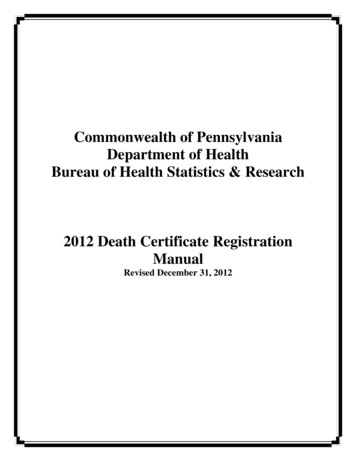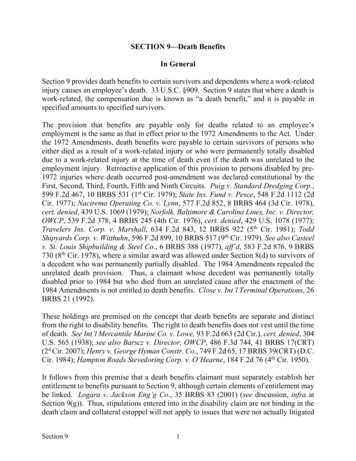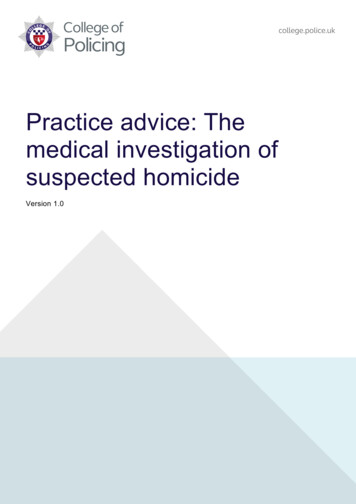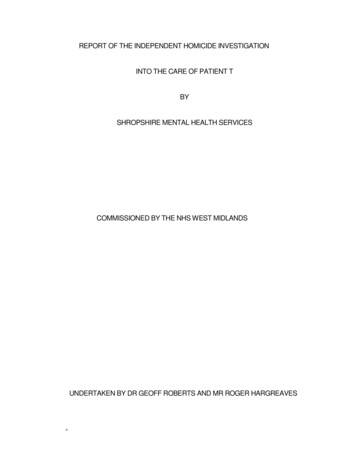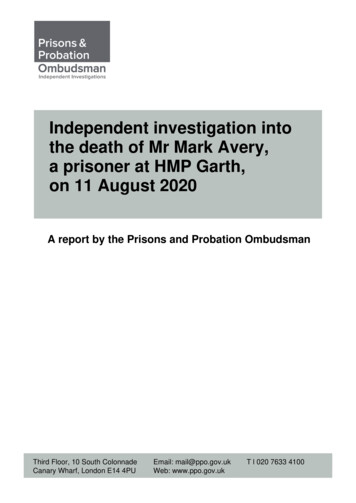
Transcription
Independent investigation intothe death of Mr Mark Avery,a prisoner at HMP Garth,on 11 August 2020A report by the Prisons and Probation OmbudsmanThird Floor, 10 South ColonnadeCanary Wharf, London E14 4PUEmail: mail@ppo.gov.ukWeb: www.ppo.gov.ukT l 020 7633 4100
Our visionTo carry out independent investigations to makecustody and community supervision safer and fairerOur valuesWe are:Impartial: we do not take sidesRespectful: we are considerate and courteousInclusive: we value diversityDedicated: we are determined and focusedFair: we are honest and act with integrity Crown copyright, 2022This report is licensed under the terms of the Open Government Licence v3.0. To view this licence,visit e/version/3Where we have identified any third-party copyright information you will need to obtain permissionfrom the copyright holders concerned.
The Prisons and Probation Ombudsman aims to make a significant contribution to safer,fairer custody and community supervision. One of the most important ways in which wework towards that aim is by carrying out independent investigations into deaths, due to anycause, of prisoners, young people in detention, residents of approved premises anddetainees in immigration centres.My office carries out investigations to understand what happened and identify how theorganisations whose actions we oversee can improve their work in the future.Mr Mark Avery died on 11 August 2020 after taking psychoactive substances (PS) at HMPGarth. He was 54 years old. I offer my condolences to Mr Avery’s family and friends.Mr Avery had a history of substance misuse. In the month before his death, prison andhealthcare staff suspected that Mr Avery had used drugs on several occasions.Healthcare staff treated Mr Avery appropriately, warned him about the risks of using PSand referred him to the prison’s substance misuse service but he refused to accept theirsupport.I am concerned that Mr Avery was able to obtain PS with apparent ease at Garth. Theprison needs to do more to reduce the availability of drugs. I am also concerned that stafffailed to submit intelligence reports on two occasions when they thought Mr Avery wasunder the influence of PS.It is possible that Mr Avery intended to end his life by using PS. He was managed underPrison Service suicide and self-harm monitoring procedures (known as ACCT) for twoweeks in July and August 2020. The ACCT was closed a week before Mr Avery’s death. Iam satisfied that closing the ACCT was a reasonable decision to have made.This version of my report, published on my website, has been amended to remove thenames of staff and prisoners involved in my investigation.Sue McAllister CBPrisons and Probation OmbudsmanApril 2021
ContentsSummary . 1The Investigation Process. 4Background Information . 5Key Events. 7Findings . 12
SummaryEvents1.On 12 December 2013, Mr Mark Avery was sentenced to 16 years imprisonment formurder. On 27 May 2014, he was moved to HMP Garth.2.Mr Avery had a history of substance misuse and several long-term health conditionsincluding asthma, epilepsy and chronic obstructive pulmonary disease (COPD – theterm for a group of serious lung diseases).3.On 1, 2 and 9 July 2020, prison and healthcare staff suspected that Mr Avery hadused psychoactive substances (PS). Healthcare staff treated Mr Averyappropriately, warned him about the risks of using PS and referred him to theprison’s substance misuse service (known as DARS). After each incident, DARSrecovery practitioners saw Mr Avery, but he refused to accept their support.4.On 27 July, a DARS recovery practitioner began Prison Service suicide and selfharm monitoring (known as ACCT) after Mr Avery said that he did not see any pointin being alive, that he had attempted to use PS to kill himself in the past and that hewas very depressed. The ACCT was closed on 4 August when Mr Avery said hefelt better as he had received help with his physical health problems.5.At 5.39pm on 11 August, an officer unlocked Mr Avery’s cell and said he was “hitwith a wall of fumes” that made him feel unsteady and which he thought was PS.The officer saw that Mr Avery was unresponsive, so he called a code blueemergency (which indicates that a prisoner is unconscious or having difficultybreathing). After two minutes, another officer responded. The officers were unsurewhether Mr Avery was breathing or had a pulse and put him in the recoveryposition.6.Three nurses and other officers then responded. The nurses found that Mr Averywas not breathing so they started cardiopulmonary resuscitation, gave him rescuebreaths and attached a defibrillator. The nurses noted that Mr Avery had “blood”and “fluid” pooling on his stomach and chest (signs that someone has been deadfor some time).7.At 5.43pm, the control room operator noted in the control room log that anambulance was needed. Four minutes later, the Ambulance Service sent a rapidresponse vehicle, which reached Mr Avery at 6.10pm. A paramedic noted that MrAvery showed pooling of blood and, at 6.12pm, declared that he had died.8.Toxicological analysis showed that Mr Avery had used PS before he died.FindingsSubstance misuse care9.The clinical reviewer was satisfied that the substance misuse care that Mr Averyreceived was equivalent to that which he could have expected to receive in thecommunity. DARS repeatedly offered Mr Avery support but he refused to engage.Prisons and Probation Ombudsman1
Physical and mental health care10.The clinical reviewer was satisfied that the physical health care Mr Avery receivedwas equivalent to that which he could have expected to receive in the community.She considered that his mental health care was of a reasonable standard and wasresponsive to his needs, though she noted three missed opportunities to discussthe negative impact that his physical health was having on his mental health and hisPS use.Reducing the supply and demand for illicit substances11.We are concerned that Mr Avery was able to obtain PS at Garth in the monthsbefore his death, despite various methods that the prison used to disrupt supply.The prison needs to review its drugs strategy. We are also concerned that stafffailed to submit intelligence reports about Mr Avery’s substance misuse on 2 and 9July.Assessment of Mr Avery’s risk12.We cannot rule out the possibility that Mr Avery used PS with the deliberateintention of taking his life. Although we found some deficiencies with Prison Servicesuicide and self-harm monitoring, we are satisfied that it was not unreasonable forstaff to have closed the ACCT a week before Mr Avery died.Emergency response13.There were delays in calling for an ambulance when Mr Avery was found. It madeno difference to the outcome for Mr Avery as he had been dead for some time, butany delay could be critical in future cases.14.We are concerned that the officers who found Mr Avery unresponsive did not startresuscitation attempts.15.We are also concerned that healthcare staff tried to resuscitate Mr Avery, despitephysical signs that he had died.Recommendations2 The Head of Healthcare should ensure that all healthcare staff are aware of thecircumstances in which a mental health referral is appropriate and make a referralwhen indicated. The Head of Healthcare should develop joint care pathways to support prisonerswith substance misuse and mental health conditions and use joint approaches tomaximise prisoners’ engagement. The Governor and Head of Healthcare should ensure that staff follow the prison’sSubstance Misuse Strategy by submitting intelligence reports when a prisoner issuspected of using illicit drugs.Prisons and Probation Ombudsman
The Governor should identify and address the key weaknesses in reducing thesupply of drugs at Garth and revise the drug strategy in light of the findings. The Head of Healthcare should ensure that healthcare staff are aware of theirresponsibility to start ACCT procedures whenever they are concerned about aprisoner’s risk of suicide or self-harm and that they clearly document their decisionmaking. The Governor should ensure that staff manage prisoners at risk of suicide and selfharm in line with national guidelines, including ensuring that they: accurately record all information disclosed in an ACCT case review; and set meaningful caremap actions, aimed at reducing the prisoner’s risk tothemselves. The Governor should ensure that all staff are aware of the importance of startingcardiopulmonary resuscitation at the earliest opportunity when a prisoner isunresponsive. The Head of Healthcare should ensure that healthcare staff are given guidanceabout the circumstances in which resuscitation is inappropriate, in accordance withEuropean Resuscitation Council Guidelines. The Governor should ensure that all staff are made aware of and understand PSI03/2013, as well as local instructions, and their responsibilities during medicalemergencies, including: immediately calling an ambulance when a medical emergency code is called;andpromptly providing information about a prisoner’s condition to the control roomso that they have this information when requesting an ambulance.Prisons and Probation Ombudsman3
The Investigation Process416.The investigator issued notices to staff and prisoners at HMP Garth informing themof the investigation and asking anyone with relevant information to contact him.Two prisoners responded but only one agreed to be interviewed by the investigator.17.The investigator obtained copies of relevant extracts from Mr Avery’s prison andmedical records.18.NHS England commissioned a clinical reviewer to review Mr Avery’s clinical care atthe prison.19.The investigator interviewed 15 members of staff and two prisoners at Garthbetween September and November 2020. The clinical reviewer joined theinvestigator for seven interviews.20.We informed HM Coroner for Lancashire and Blackburn with Darwen of theinvestigation. He gave us the results of the post-mortem examination. We havesent the coroner a copy of this report.21.One of the Ombudsman’s family liaison officers contacted Mr Avery’s sister toexplain the investigation and to ask if she had any matters she wanted theinvestigation to consider. Mr Avery’s sister asked for a copy of the report but didnot have any specific matters she wanted the investigation to consider.22.The initial report was shared with HM Prison and Probation Service (HMPPS).HMPPS did not find any factual inaccuracies.23.Mr Avery’s sister received a copy of the initial report. She did not make anycomments.Prisons and Probation Ombudsman
Background InformationHMP Garth24.HMP Garth holds up to 845 prisoners serving sentences of four years or longer orindeterminate sentences. Greater Manchester Mental Health NHS FoundationTrust provides primary care, mental health and clinical substance misuse servicesand Delphi Medical provides non-clinical substance misuse services.HM Inspectorate of Prisons25.The most recent inspection of HMP Garth was in December 2018/January 2019.Inspectors reported that 60% of prisoners said that it was easy to obtain drugs inthe prison and that 25% of prisoners said they had developed a drug habit at Garth.However, inspectors found that intelligence gathering was generally managedadequately, with good collaboration between the security department and the rest ofthe prison. They found that substance misuse services worked well to address drugissues, though many initiatives to reduce drug use had not been fully embedded.26.Inspectors also reported that staff had received ‘Emergency Response in Custody’(ERIC) cards which described the emergency codes, and that ambulances werecalled promptly during emergencies.Independent Monitoring Board27.Each prison has an Independent Monitoring Board (IMB) of unpaid volunteers fromthe local community who help to ensure that prisoners are treated fairly anddecently. In its latest annual report, for the year to November 2019, the IMBreported that the prison had a positive drug strategy, with good support from thedrug strategy team, though drug use remained a major problem.Previous deaths at HMP Garth28.Mr Avery was the 11th prisoner to die at Garth since August 2018. Three of theprevious deaths were self-inflicted, four were drug-related and three were fromnatural causes. We have previously made recommendations about reducing thesupply of drugs, the need to submit intelligence reports about substance misuse,the need to call ambulances promptly during emergencies and the management ofACCT plans.Psychoactive substances (PS)29.Psychoactive substances, previously known as ‘legal highs’ are a problem acrossthe prison estate. They are difficult to detect and can affect people in a number ofways including increasing heart rate, raising blood pressure, reducing blood supplyto the heart and vomiting. Prisoners under the influence of PS can present withmarked levels of disinhibition, heightened energy levels, a high tolerance of painand a potential for violence. Besides emerging evidence of such dangers toPrisons and Probation Ombudsman5
physical health, there is potential for precipitating or exacerbating the deteriorationof mental health with links to suicide or self-harm.30.In July 2015, we published a Learning Lessons Bulletin about the use of PS and itsdangers, including its close association with debt, bullying and violence. Thebulletin identified the need for better awareness among staff and prisoners of thedangers of PS; the need for more effective drug supply reduction strategies; bettermonitoring by drug treatment services; and effective violence reduction strategies.Assessment, Care in Custody and Teamwork631.Assessment, Care in Custody and Teamwork (ACCT) is the Prison Service careplanning system used to support prisoners at risk of suicide and self-harm. Thepurpose of ACCT is to try to determine the level of risk, how to reduce the risk andhow best to monitor and supervise the prisoner.32.After an initial assessment of the prisoner’s main concerns, levels of supervisionand interactions are set according to the perceived risk of harm. Checks should beirregular to prevent the prisoner anticipating when they will occur. There should beregular multidisciplinary review meetings involving the prisoner. As part of theprocess, a caremap (plan of care, support and intervention) is put in place. TheACCT plan should not be closed until all the actions of the caremap have beencompleted.33.All decisions made as part of the ACCT process and any relevant observationsabout the prisoner should be written in the ACCT booklet, which accompanies theprisoner as they move around the prison. Guidance on ACCT procedures is set outin Prison Service Instruction (PSI) 64/2011, Management of prisoners at risk ofharm, to self, to others and from others (Safer Custody).Prisons and Probation Ombudsman
Key Events34.On 12 February 2013, Mr Mark Avery was remanded in prison custody and sent toHMP Hewell. On 13 December, Mr Avery was sentenced to life imprisonment, witha minimum 16-year tariff, for murder.35.On 27 May 2014, after spending time at various prisons, Mr Avery was moved toHMP Garth.36.Mr Avery had several long-term health conditions, including asthma, epilepsy andprogressively worsening chronic obstructive pulmonary disease (COPD – a group oflung conditions that cause breathing difficulties). Mr Avery also had a history ofdepression and substance misuse, including abusing alcohol and cannabis.37.In June 2017 and February 2018, prison and healthcare staff suspected Mr Averywas under the influence of drugs; and throughout 2018, 2019 and 2020, theysuspected that he was sending money to members people outside prison to pay fordrugs. Mr Avery also refused two mandatory drug tests in January 2018 and inMarch 2019. However, despite these concerns, Mr Avery refused to work with theprison’s Drug and Alcohol Recovery Service (DARS).202038.On 1 July 2020, an officer found that Mr Avery was struggling to breathe and notedthat there was a strong smell of psychoactive substances (PS) in his cell. Mr Averyadmitted having smoked PS. The officer called a code blue emergency (whichindicates that a prisoner is unconscious or having difficulty breathing) and a nurseresponded. She took Mr Avery’s basic observations, decided that Mr Avery did notneed to go to hospital and told him that it was likely that he would die if hecontinued to use PS. Mr Avery said that he was “silly to use PS”, that it took awayhis depression, that he had “nothing to lose anymore” and that he would not bebothered if he was dead, though he did not have thoughts about taking his life. Shereferred Mr Avery to DARS, a prison GP and the mental health team.39.Following the code blue emergency, an officer submitted an intelligence reportabout Mr Avery’s admission that he had used PS.40.Later that day, a prison GP saw Mr Avery to review his prescription for oramorph (aliquid form of morphine which had been prescribed to alleviate his breathlessness).Mr Avery said that he could have died from using PS. The GP decided to withholdMr Avery’s oramorph prescription for 24 hours as no-one knew what PS he hadused.41.Later that day, a DARS recovery practitioner saw Mr Avery and gave him harmreduction advice, though Mr Avery denied having a problem and refused to acceptsupport from DARS.42.On 2 July, a prison GP spoke to a hospital respiratory consultant about Mr Avery’soramorph prescription and his illicit drug use. The consultant considered that therisks of using oramorph outweighed the benefits, so the GP stopped theprescription.Prisons and Probation Ombudsman7
843.Later that day, an officer found that Mr Avery was struggling to breathe and notedthat there was a strong smell of an unknown substance in his cell. The officercalled a code blue emergency and two nurses responded. They took Mr Avery’sbasic observations and asked paramedics, who were already in the establishment,to assess him, but they decided not to take him to hospital. One nurse referred MrAvery to DARS and asked other healthcare staff to review the medication he wasallowed in his possession. The other nurse asked prison staff to check on himregularly.44.On 3 July, a prison GP reviewed Mr Avery’s prescribed medication. He decidedthat, due to Mr Avery’s use of PS, he could not keep his amitriptyline anddihydrocodeine medication (used to treat Mr Avery’s pain) in possession because ofthe dangers of taking these drugs at the same time as PS.45.Later that day, a DARS recovery practitioner saw Mr Avery and gave him harmreduction advice, though he refused to discuss it or accept support from DARS.46.On 5 July, an officer found that Mr Avery was struggling to breathe while using hisnebuliser. The officer called a code blue emergency and a nurse responded. Shetook Mr Avery’s basic observations and sent him to hospital as an emergency.While in hospital, doctors treated him for an exacerbation (worsening) of his COPD.He returned to the prison from hospital on the evening of 8 July.47.On 9 July, a nurse reviewed Mr Avery and noted a very strong smell of illicitsubstances and that his cell was smoky. Mr Avery denied using illicit substancesand said that it was the general smell on the wing. She noted that Mr Averyappeared to be alert and orientated. She explained to him that he could die fromusing PS, based on his age, weight and diagnosis of COPD. Mr Avery said heunderstood this and insisted that he had not used PS, though an officer agreed thatthe smell and smoke was coming from his cell. She referred Mr Avery to DARS.She also asked officers to monitor Mr Avery overnight and asked other healthcarestaff to consider withholding his prescription.48.Later that day, a nurse saw Mr Avery to attempt a mental health assessment.However, he could not see Mr Avery in private and Mr Avery was not prepared todiscuss personal details in public.49.Later that day, a healthcare administrator noted that Mr Avery refused to attend apost-PS review.50.On 14 July, a prison GP saw Mr Avery, who said that he felt better after being seenin hospital. They also discussed the risks of using PS.51.Three days later, a healthcare administrator contacted the prison GPs and askedthem to ensure that Mr Avery was not allowed his prescription medications in hispossession, as healthcare staff were concerned that they could be traded for illicitdrugs. Later that day, a prison GP noted this concern.52.On 24 July, a nurse saw Mr Avery for a short-term mental health intervention. MrAvery said that he was unhappy being locked in his cell due to the COVID-19restrictions, though the nurse did not note any evidence of depression. Mr Averyclaimed to only have used PS two weeks ago, though prison officers consideredPrisons and Probation Ombudsman
that he used it more often. The nurse advised him to stop using PS, due to thepotential risks, but Mr Avery said he was dying anyway so it was his decision. Thenurse referred him to DARS.53.On the morning of 27 July, a DARS recovery practitioner saw Mr Avery, whorefused to work with DARS. Mr Avery said that he did not see any point in beingalive, that he had attempted to use PS to kill himself in the past and that he wasvery depressed. At 9.20am, she began Prison Service suicide and self-harmmonitoring (known as ACCT).54.Ten minutes later, a supervising officer (SO) completed an Immediate Action Plan,instructed staff to observe Mr Avery twice an hour and referred him to the mentalhealth team for a review.55.At 2.00pm, the SO held the first ACCT case review with Mr Avery and an officer.The SO noted that he had been unable to get any mental health staff to attend thereview. Mr Avery said that he was frustrated about his declining physical health andthat he “sometimes” thought about taking his own life, though he had no plans to doso. The attendees assessed that Mr Avery presented a raised risk of suicide andself-harm (on a scale of low, raised and high) and they kept the level ofobservations the same.56.That same day, a prison GP reviewed Mr Avery’s medication in the light of hisincidents of severe breathlessness and his deteriorating COPD, which wasexacerbated by persistent use of PS. He decided that it was too unsafe for MrAvery to keep his medication in possession, so he arranged for him to use awheelchair to collect his medication.57.At 9.00am on 28 July, the SO held the second ACCT case review with Mr Avery,another SO and a nurse. The SO noted that Mr Avery appeared in high spiritscompared to the previous review. Mr Avery said that he did not feel suicidal but thatcould change at any time. The attendees assessed that Mr Avery presented a lowrisk of suicide and self-harm and they reduced the level of observations to one anhour.58.The SO added two actions to Mr Avery’s caremap (designed to identify the mainareas of concern and the actions required to reduce risk): that he needed apersonal emergency evacuation plan and his own wheelchair.59.The nurse recorded additional information in Mr Avery’s electronic medical record(known as SystmOne). Mr Avery said that he had stopped using PS, would not useit in the future and that he would work with the DARS team. The nurse noted thatMr Avery’s physical state dominated the review so there was no need for mentalhealth to attend any future ACCT case reviews.60.On 4 August, a SO held the third ACCT case review with Mr Avery and another SO.Mr Avery said that he felt a lot better as he had been given a wheelchair and a carerand was due to see a consultant about his COPD and angina. The attendeesdecided that the ACCT could be closed.Prisons and Probation Ombudsman9
11 August 202061.At 11.09am on 11 August, a SO held an ACCT post-closure interview with MrAvery, who said that he felt better than he had, despite his numerous healthconditions. The SO decided that there was no need to re-open the ACCT or hold asecond interview with Mr Avery.62.At approximately 4.15pm, an officer visited Mr Avery’s cell, gave him a toilet roll andpulled the door closed.63.Around 15 minutes later, Officer A locked Mr Avery’s cell. CCTV footage showsthat he spent only seconds at Mr Avery’s door and did not look into the cell.64.At approximately 5.35pm, Officer A and Officer B started unlocking certain cells tolet prisoners out to collect their evening medication. At about 5.37pm, Officer Aunlocked the door to Mr Avery’s cell and Officer B unlocked the neighbouring cell.Officer A said he was “hit with a wall of fumes” from Mr Avery’s cell that he thoughtwas PS. He described the fumes as smelling of “burning plastic” and said theymade him feel unsteady on his feet. Officer B appeared not to be aware of this asCCTV footage shows that he walked away from his colleague and left the wing.65.At 5.39pm, Officer A realised that Mr Avery was unresponsive, so he called a codeblue medical emergency. Officer A and two prisoners briefly entered Mr Avery’scell. Two minutes after unlocking Mr Avery’s cell, as Officer B walked along thecorridor in response to the code blue emergency, Officer A entered and remained inthe cell. Officer B then also entered the cell.66.During his interview, Officer A told the investigator that he checked Mr Avery’s pulseand breathing and thought that he felt both. However, during their interviews,Officer B and the two prisoners said that they thought that Mr Avery was notbreathing and did not have a pulse. The two officers placed Mr Avery in therecovery position.67.More staff then responded. The nurses found that Mr Avery was not breathing sothey started cardiopulmonary resuscitation (CPR). The nurses also gave Mr Averyrescue breaths using an Ambu-bag and attached a defibrillator which did not detecta shockable heart rhythm and advised to continue CPR. On their SystmOneentries, the nurses noted, respectively, that Mr Avery had “blood” and “fluid” poolingon his stomach and chest.68.At 5.43pm, as noted on the Control Room Daily Log, the control room operatornoted that an ambulance was needed. According to the Log, the prison made thefirst of four telephone calls to the Ambulance Service at 5.47pm, although anoperational support grade told the investigator that this would have been the timethat the call finished. The North West Ambulance Service sent a rapid responsevehicle and it reached Mr Avery at 6.10pm. A paramedic noted that Mr Averyshowed hypostasis (pooling of blood) and, at 6.12pm, declared that he had died.69.Following Mr Avery’s death, Lancashire Police seized and examined twohomemade smoking devices found in Mr Avery’s cell. The forensic report notedthey contained PS.10 Prisons and Probation Ombudsman
Contact with Mr Avery’s family70.Throughout Mr Avery’s time in custody he had listed his sister as his next of kin, buton his electronic prison record (known as NOMIS) staff had recorded her addressbut not her telephone number.71.Following Mr Avery’s death, the prison appointed a SO as the prison’s family liaisonofficer. In the absence of a telephone number for Mr Avery’s next of kin, theGoverning Governor decided that to avoid a delay searching his records for atelephone number, the police should be asked to visit her home address to breakthe news of his death. At approximately 1.00am on 12 August, West MidlandsPolice visited the home address of Mr Avery’s next of kin and broke the news of hisdeath.72.At 11.50am, the SO telephoned Mr Avery’s sister to introduce herself and to offerher condolences and support.73.The SO continued to support Mr Avery’s sister until his funeral, which was held on 2September. The prison contributed towards the costs of the funeral in line withnational instructions.Support for prisoners and staff74.After Mr Avery’s death, a prison manager debriefed some of the staff involved in theemergency response to ensure they had the opportunity to discuss any issuesarising, and to offer support. The staff care team also offered support.75.The prison posted notices informing other prisoners of Mr Avery’s death, andoffering support. Staff reviewed all prisoners assessed as being at risk of suicide orself-harm in case they had been adversely affected by Mr Avery’s death.Post-mortem report76.The post-mortem examination, completed before a toxicological analysis took place,considered that, if the analysis was inconclusive, then the cause of Mr Avery’sdeath was coronary artery disease.77.A toxicological analysis found that Mr Avery’s blood and urine contained syntheticcannabinoids (PS). The toxicology report noted that the toxic effects of syntheticcannabinoids include abnormally fast heart rate, collapse, seizures, vomiting andmood disorders, and that the type of PS found in Mr Avery’s blood and urine hadsubjectively stronger effects than other cannabinoids. The analysis also found thepresence of medications prescribed to Mr Avery, though they were not at levels thatcould have caused his death.Prisons and Probation Ombudsman 11
FindingsSubstance misuse care78.Mr Avery had a long history of substance misuse and continued to use illicitsubstances at Garth. The clinical reviewer was satisfied that DARS repeatedlyoffered him support but, on each occasion, Mr Avery declined their support. Theclinical reviewer was also satisfied that healthcare staff treated Mr Averyappropriately when he was found under the influence, made repeated attempts toremind him of the dangers of using PS and took steps to review and wit
Prison Service suicide and self-harm monitoring procedures (known as ACCT) for two . and Delphi Medical provides non-clinical substance misuse services. HM Inspectorate of Prisons . vehicle and it reached Mr Avery at 6.10pm. A paramedic noted that Mr Avery showed hypostasis (pooling of blood) and, at 6.12pm, declared that he had died. .




